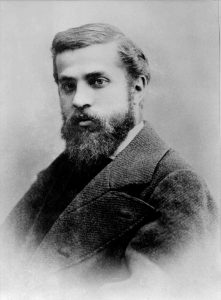
Antoni Gaudí Life and Facts
Antoni Gaudí y Cornet (1852–1926) was a Spanish architect whose idiosyncratic work, characterized by undulating curves and richly colored scrambled textures, won broad international recognition only after the mid-20th century.
Antonio (Antoní is the Catalan spelling) Plácido Guillermo Gaudí was born in Reus, in the Catalan region of Spain, on June 25, 1852.
As a young person, he went to nearby Barcelona, where he studied at the School of Architecture. He did architectural work to help support himself and thus acquired experience.
The great Gothic cathedral in Barcelona and the many neo-Renaissance secular buildings in the city were significant sources of inspiration for Gaudí, who remained in Barcelona for the rest of his life.
By the time he completed his formal studies, Gaudí had already begun to develop his unique style—blending elements of Gothic art, art nouveau, known as “modernismo” in Catalonia, and functional structure.
His favorite forms were inclined columns to add stress to ceilings, paraboloid arches, thin edge-butted tile vaults, and the richest, most colorful textures possible, often mosaics made of broken tile scraps.
Soon, he found wealthy patrons in Barcelona who favored his elaborate style with art nouveau whiplash curves and its exuberance of colorful textured surfaces. For shipping magnata and textile manufacturer Eusebio Güell Bacigalupi, his most important patron, Gaudí built a palace (1885–1889), now a museum. The building is marked by its fantastic roof line, parabolic arched entrances, and lavish ironwork.
Among his other works for Güell are the brilliantly imaginative park, the Park Guell (1900–1914), and the lower part of a chapel (1898–1915), remarkable for its thin shell vaults held up by inclined pillars.
He had other patrons who were also resident in Barcelona and for whom he constructed the Casa Vicens (1878–1880) and the Casa Batlló (1905–1907).
It was the most outlandish Casa Milà (1905–1910) in which the artist carried his double-curved walls to their most extreme limits.
Gaudí died in Barcelona on June 10, 1926, after being hit by a streetcar. His most extraordinary project, the Church of the Sagrada Familia in Barcelona, was left unfinished at his death. He had begun work on the church as early as 1884. From 1910 to 1926, however, he devoted his efforts exclusively to his masterpiece.
Although its construction continued haphazardly and at a slow pace through the 1990s—and will most likely do so into the 21st century—the vast church, with its hyperbolic paraboloids (saddle-shaped curves) and wealth of decorative elements, stands out as one of the 20th century’s grand religious edifices.
In 1922, the great American architect Louis Sullivan said Gaudí’s Church of the Sagrada Familia was “spirit symbolized in stone.” At that time, few people could appraise his statement, for although well known in Catalonian Spain, Gaudí’s work was neglected outside his native country after the mid-1920s.
Partly owing to the surrealists fascinated by the fantastic element in his work, but mainly owing to architects and art historians, Gaudí’s genius finally became widely appreciated. However, this did not occur until more than 30 years after his death.